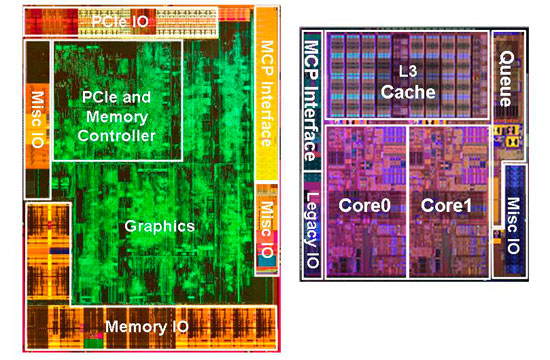Intel’s Core i5-655K & Core i7-875K: Overclocked and Analyzed
by Rajinder Gill on May 28, 2010 5:00 AM ESTBetter than our i3-540 for Overclocking?
Part of the attraction generated by the allure of unlocked multiplier processors is the additional flexibility purportedly provided, allowing any manner of clock domain frequency combinations. The obvious question has to be what an unlocked multiplier set offers the Clarkdale topology? The real ticket to retaining performance on this platform is to keep QPI frequency as close as possible to processor core frequency. That’s because the memory controller is off-die and the CPU communicates with the memory controller via the QPI link (the data link between the MCP stages in the images below).

Too wide a gap between both clock domains and the CPU must hold data for longer periods of time in the associated buffer stage before it can be transferred to the next bus. As a result, setting too high a CPU multiplier with too low a reference clock (BCLK) would neglect QPI bus frequency. This is because Intel limits the range of QPI multipliers at our disposal. What we want to use is a CPU core multiplier that is the same as or one notch higher than the QPI multiplier ratio.
Another thing that becomes readily apparent with the Clarkdale topology is that memory speeds around the DDR-3 1800 mark are generally the upper limit for most processors when absolute stability is required at reasonable voltage levels. Slightly higher speeds are possible but only by sacrificing valuable memory access latency – meaning you have to either run loose memory timings or drop QPI frequency to compensate. Given the choice, we’d sacrifice a little memory bandwidth before sacrificing a lot (lowering the QPI frequency). With this in mind, all of our comparisons have been made using the highest available QPI multiplier ratio on each processor, with the actual QPI frequency closely matched:











51 Comments
View All Comments
Ph0b0s - Friday, May 28, 2010 - link
Not covered so much on these websites but I slurged on an I7 965 when I7's were new, becuase it was unlocked, even though I knew it did not have any extra head room than the cheap chips in the family. The reason I did this was so that I could use the I7's new turbo feature to overclock on demand instead of having to use static timings to overclock. With unlocked I7's and the right motherboard you can change the value of the turbo mulipliers to be more than just one or two steps.So for my chip if I have all 4 cores in use my turbo muliplier is set to x29 (3800 ghz, only using factory voltages at the moment) and higher amounts when less cores are in use. So when not doing anything my CPU clocks itself to 1.6 GHz and runs at 3.2 GHz if not doing too much and then clocks itself to 3.8GHz when extra power is needed.
So I really welcome Intel putting out these cheaper unlocked CPU's, as next time when I want to overclock using the turbo funtionality I won't have to fork out for an Extreme Edition again.
Also I would love to see more coverage of this type of overclocking that it is new with the Nathelems, Before it was only the I7 Extreme Edition chips that could do it, but now that are more options avaliable, maybe Anandtech could do an article taking about it.
Death666Angel - Friday, May 28, 2010 - link
Hello guys!I was really looking forward to Intel -K material. But the whole bunch of "i5 540" is more than an annoyance. It is downright embarrassing and I would urge you to re-read any future texts, as I am really not interested in reading stuff when so little time is put into the text. Really a shame since the content is looking good.
Rajinder Gill - Friday, May 28, 2010 - link
Sorry, blame me for that. Those skipped under the radar this morning.-Raja
Griswold - Friday, May 28, 2010 - link
If you wonder why Intel does this, it most likely boils down to two letters: BE. They were never priced as if they came straight out of Absurdistan. And perhaps Intel felt a little itch because of that...Maroon - Friday, May 28, 2010 - link
^^^we have a winner!DanNeely - Friday, May 28, 2010 - link
Where are you getting those numbers from? Software or are you using hardware to measure it directly off the mobo itself?Rajinder Gill - Friday, May 28, 2010 - link
Hardware measured using a clamp meter.Raja
DanNeely - Sunday, May 30, 2010 - link
So you were measuring the current going into the mobo via the 4/8pin 12V cpu power cable?Rajinder Gill - Monday, May 31, 2010 - link
Yes.DanNeely - Tuesday, June 1, 2010 - link
Did you also monitor the main ATX power connector to see if there was any increase in power draw there when overclocking?